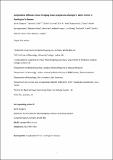Longitudinal diffusion tensor imaging shows progressive changes in white matter in Huntington’s disease
Abstract
BACKGROUND: Huntington’s disease is marked by progressive neuroanatomical changes, assumed to underlie the development of the disease’s characteristic symptoms. Previous work has demonstrated longitudinal macrostructural white-matter atrophy, with some evidence of microstructural change focused in the corpus callosum. OBJECTIVE: To more accurately characterise longitudinal patterns, we examined white matter microstructural change using Diffusion Tensor Imaging (DTI) data from three timepoints over a 15 month period. METHODS: In 48 early-stage HD patients and 36 controls from the multi-site PADDINGTON project, diffusion tensor imaging (DTI) was employed to measure changes in fractional anisotropy (FA) and axial (AD) and radial diffusivity (RD) in 24 white matter regions-of-interest (ROIs). RESULTS: Cross-sectional analysis indicated widespread baseline group differences, with significantly decreased FA and increased AD and RD found in HD patients across multiple ROIs. Longitudinal rates of change differed between HD patients and controls in the genu and body of corpus callosum, corona radiata and anterior limb of internal capsule. Change in RD in the body of the corpus callosum was associated with baseline disease burden, but other clinical associations were not significant. CONCLUSIONS: We detected subtle longitudinal white matter changes in early HD patients. Progressive white matter abnormalities in HD may not be uniform throughout the brain, with some areas remaining static in the early symptomatic phase. Longer assessment periods across disease stages will help map this progressive trajectory.
Citation
Gregory , S , Cole , J H , Farmer , R E , Rees , E M , Roos , R A C , Sprengelmeyer , R H , Duerr , A , Landwehrmeyer , B , Zhang , H , Scahill , R I , Tabrizi , S J , Frost , C & Hobbs , N Z 2015 , ' Longitudinal diffusion tensor imaging shows progressive changes in white matter in Huntington’s disease ' , Journal of Huntington's Disease , vol. 4 , no. 4 , pp. 333-346 . https://doi.org/10.3233/JHD-150173
Publication
Journal of Huntington's Disease
Status
Peer reviewed
Type
Journal article
Description
This work has been supported by the European Union — PADDINGTON project and all authors, with the exception of RS, SG and HZ receive funding from this project. RS, SG and HZ are supported by the CHDI/High Q Foundation, a not-for-profit organization dedicated to finding treatments for Huntington's disease. This work was undertaken at UCLH/UCL supported by the National Institute for Health Research [NIHR] University College London Hospitals [UCLH] Biomedical Research Centre [BRC].Collections
Items in the St Andrews Research Repository are protected by copyright, with all rights reserved, unless otherwise indicated.

